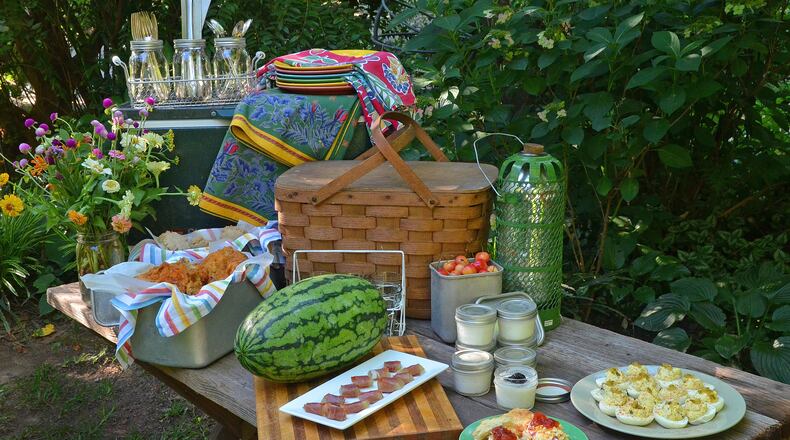No summer is complete without backyard barbecues, cookouts and picnics. However, there are certain risks to keep in mind when preparing and eating food outside, especially in Georgia’s hot weather.
According to the U.S. Centers for Disease Control and Prevention, an estimated 48 million people contract foodborne illnesses each year, resulting in approximately 128,000 hospitalizations and 3,000 deaths. The U.S. Department of Agriculture’s Food Safety and Inspection Service recommends following these tips to keep your summer meals safe from beginning to end:
- Before handling any food, wash your hands with soap and warm water for 20 seconds to prevent spreading any germs to the food. In addition, rinse any fruits and vegetables under running tap water. Remember to wash your hands again after handling any raw foods.
- Clean all surfaces where you will be preparing food, whether you're in the kitchen or outside at the grill. Prepare vegetables and fruits separately from meats. To prevent cross-contamination, any utensils, platters or cutting boards used to prepare raw foods should not be used to handle cooked food.
- If you're having a picnic, make sure all of your equipment is clean before packing. Use separate coolers and containers to keep cold and warm foods at the proper temperatures. For example, store foods like pasta salad, lunch meats and fried chicken insulated in a cooler; whole fresh fruits and vegetables do not have to be chilled. Don't forget to bring wipes or moist towelettes.
- When preparing frozen foods, follow proper thawing techniques to ensure food is safe from bacteria. Food should never be set on a countertop to thaw at room temperature or defrosted under hot water. Also, when marinating food, always marinate it in the refrigerator.
Food can be thawed in the refrigerator, and will safely last an additional day or two before cooking. When thawing food in a microwave, cook it immediately after thawing; do not place it back in the refrigerator. When thawing food in cold water, seal the food in leak-proof packaging or a plastic bag and submerge in a container under cold tap water. Replace the water every 30 minutes.
- When it comes to grilling, barbecuing or roasting meat, poultry or fish, use a food thermometer to ensure that it is cooked to the proper internal temperature to ensure foodborne pathogens are eliminated. Nearly two-thirds of Americans do not use food thermometers, so pathogens that make you sick may still be present, said Archie Magoulas, a technical information specialist with the USDA's FSIS.
Food thermometers can be purchased at most grocery or kitchen equipment stores. Follow instructions to properly calibrate the thermometer, then place it into the thickest part of the food. While using a food thermometer takes getting used to, these inexpensive tools ensure dangerous bacteria are destroyed and can prevent any overcooking of meat, Magoulas said. Also be sure to clean the thermometer between uses.
Fish and whole cuts of pork, lamb, veal and beef should be cooked to 145 degrees Fahrenheit. Once the internal temperature has been reached, these meats should be removed from heat and allowed to “rest” for three minutes. During this period, the internal temperature will rise or remain constant, which will kill remaining pathogens.
Hamburgers, sausages and other ground meats should reach an internal temperatures of 160 degrees; poultry should reach a minimum 165 degrees. Hot dogs should be heated to steaming hot.
- It's easy to get distracted by the lure of a cool swimming pool or a backyard football game after you finish eating, but don't forget about your food, Magoulas said. Leftovers should be refrigerated or frozen immediately. Any food that is left out in temperatures above 40 degrees for more than two hours should be discarded; in hot weather (90 degrees or higher), food should not be left out longer than one hour.
“While some foods do spoil quicker than others, like milk or soft cheeses, all food should be discarded if it’s left out for over two hours,” Magoulas said. “Any longer than that gets very risky. Bacterial growth increases exponentially every half hour.”
- To properly store leftovers, make sure your refrigerator temperature never exceeds 40 degrees. Frozen food will last the longest if the freezer maintains a temperature of 0 degrees.
- Before leaving town on vacation, remember to remove any perishable food items that will spoil before you return to prevent mold and bacteria growth. You can download the Food Keeper app on your cellphone to determine where and for how long to keep different foods.
WHERE TO CALL
If you have any food-related questions or complaints, call the USDA Meat and Poultry Hotline (1-888-674-6854), which is staffed by dietitians, home economists, and food safety experts. It has extended its hours and is now available from 10 a.m. to 6 p.m. EST Mondays-Fridays in both English and Spanish. You can also ask questions anytime through email or chat at AskKaren.gov. More information can be found at www.fsis.usda.gov.
About the Author
Keep Reading
The Latest
Featured



